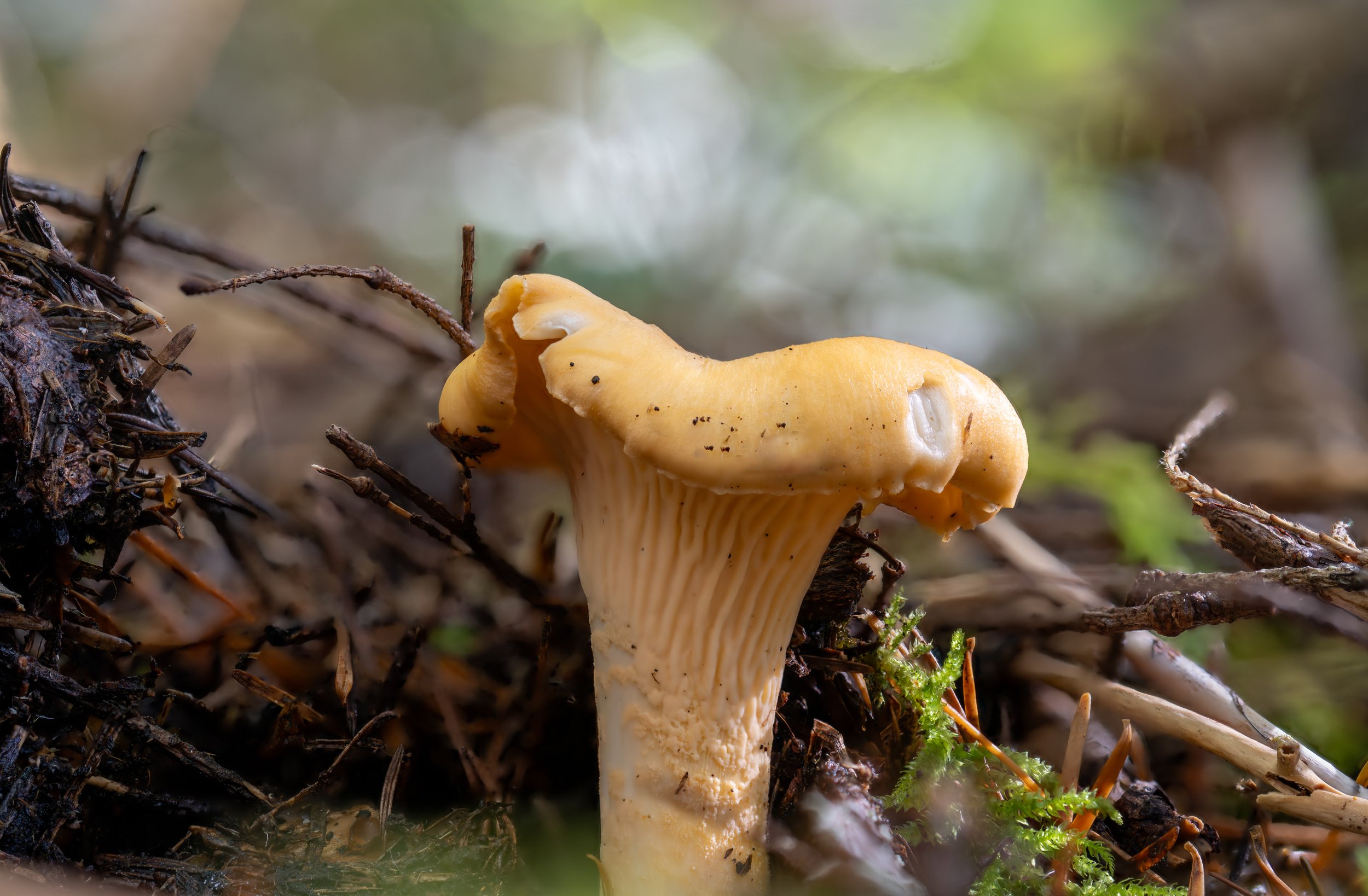Chanterelle
Genera: Cantharellus, Craterellus, Gomphus, and Polyozellus
See artwork and accessories in our shop celebrating the Chanterelle mushroom!
-
Please refrain from picking and consuming mushrooms without proper guidance. If you have an interest in learning how to forage, I strongly encourage you to join your local mycological society. You can find a list of clubs across America, organized by state, on the North American Mycological Society's website.


Etymology: This mushroom's name derives from the Latin word 'cantharus' and the Greek word 'kantharos' (κάνθαρος), meaning cup or drinking vessel. The name 'Chanterelle' can refer to many different species of fungi within the Cantharellus, Craterellus, Gomphus, and Polyozellus genera, though only those in the Cantharellus genus are considered 'true Chanterelles'.
Other Names:
Due to their worldwide spread and popularity, there are A LOT of common names for the chantarelle. See a list of them on page 9 of the Ecology and Management of Commercially Harveste Chanterelle Mushrooms report. Here are some of my favorite or more notable names:
France: Girolle - Comes from "girer" meaning twist
Italian: Galletto - Young Rooster
Japan: Anzutake (杏茸) - Apricot mushroom
Portuguese: Canarinhos - Canary bird
Spanish (Europe and South America): Rebozuelo - Woman’s Dress
Location: There are many different types of chanterelles that can be found spread across every continent, excluding Antarctica.
Ecological Group: Mycorrhizal, meaning they form complex relationships with the roots of various trees and shrubs, trading resources such as water and minerals for nutrients.
Edible? Yes! The chanterelle is one of the most highly prized edible fungi, with many people describing it as having a fruity aroma similar to apricots.
-
The Pacific Golden Chanterelle (Cantharellus formosus) is Oregon's state mushroom (State Symbols USA, 2017)
The California Golden Chanterelle (Cantharellus californicus) is California’s state mushroom (California State Mushroom, 2023)
Many Western European countries, such as England and Germany, were considered to be quite mycophobic. It wasn't until the 1880s that they started eating fungi regularly, with the Chanterelle being a strong contributing factor to this change (Pilz et al, 2003; Pegler et al, 1997).
Chanterelles are consumed all over the world, from being used in soups in Thailand (NAFRI, 2014) and pickled in Russia (Boyd, 1958) to being used in medicine for night blindness in China (Pegler et al, 1997) and various dishes in native Oaxacan groups (Santiago et al, 2014).
-
The part of the Chanterelle that produces spores is described as “false gills” because they are just wrinkles or veins on (Pilz et at, 2003).
Over 40 species of Chanterelles are recognized growing in North America, and around 90 have been described worldwide (though this number may vary depending on who you ask) (Pilz et al, 2003).
-
Due to their complex relationship with trees, large-scale cultivation of Chanterelles is challenging. It necessitates several years to establish an orchard with the suitable trees, which are subsequently inoculated with Chanterelle mycelium. (Pilz et al, 2003)
The Chanterelle market in 2000 was estimated to be worth between $1.25 billion to $1.4 billion annually, with sales exceeding 200,000 metric tons (441 million lbs.) per year! (Pilz et al, 2003)
The size, shape, and color of chanterelles can vary greatly between regions. For example, those found in California are some of the largest in the world, while the ones found in the rocky mountains are much smaller. (Arora, 1991)
Learn More
Tom Volk’s Fungus of the Month - Amazing blog posts about all sorts of fun fungi!
Cantharellus cibarius (The Chanterelle) - This is the most popular and well known chanterelle species
Craterellus Fallax (The black trumpet) - One of the most sought after species of Chanterelle
Ecology and Management of Commercially Harvested Chanterelle Mushrooms - If you really want a deep dive into Chanterelles, this publication released in 2003 is incredibly thorough and detailed, covering many aspects of the Chanterelle.
References
Arora, D. (1991). All that the rain promises and more: A Hip Pocket Guide to Western Mushrooms.
Wasson, V. P., & Wasson, R. G. (1958). Mushrooms Russia and History (Vol. 1) Pantheon Books New York. [link]
NAFRI. (2014, February 18). ເຫັດແສດໃຫຍ່ / Chanterelle. Pha Khao Lao. https://www.phakhaolao.la/en/kb/0000073
Pegler, D. N., Roberts, P. J., Spooner, B. M. (1997). British Chanterelles & Tooth-Fungi: An Account of the British Cantharelloid & Stipitate Hydnoid Fungi. United Kingdom: Royal Botanic Gardens. [Google Books]
California State Mushroom, A.B. 261, 2023–2024 Reg. Sess. (Cal. 2023). https://leginfo.legislature.ca.gov/faces/billNavClient.xhtml?bill_id=202320240AB261
Pilz, D., Norvell, L. L., Danell, E., & Molina, R. (2003). Ecology and management of commercially harvested chanterelle mushrooms. https://doi.org/10.2737/pnw-gtr-576 [Link]
Santiago, F. H., Moreno, J. P., Cázares, B. X., Suárez, J. J. A., Trejo, E. O., de Oca, G. M. M., & Aguilar, I. D. (2016). Traditional knowledge and use of wild mushrooms by Mixtecs or Ñuu savi, the people of the rain, from Southeastern Mexico. Journal of Ethnobiology and Ethnomedicine, 12, 1-22. [Link]
State Symbols USA - Pacific Golden Chanterelle Mushroom. (2017, September 12). State Symbols USA. https://statesymbolsusa.org/symbol-official-item/oregon/state-food-agriculture-symbol/pacific-golden-chanterelle
Disclaimer: Please refrain from picking and consuming mushrooms without proper guidance. If you have an interest in learning how to forage, I strongly encourage you to join your local mycological society. You can find a list of clubs across America, organized by state, on the North American Mycological Society's website.


